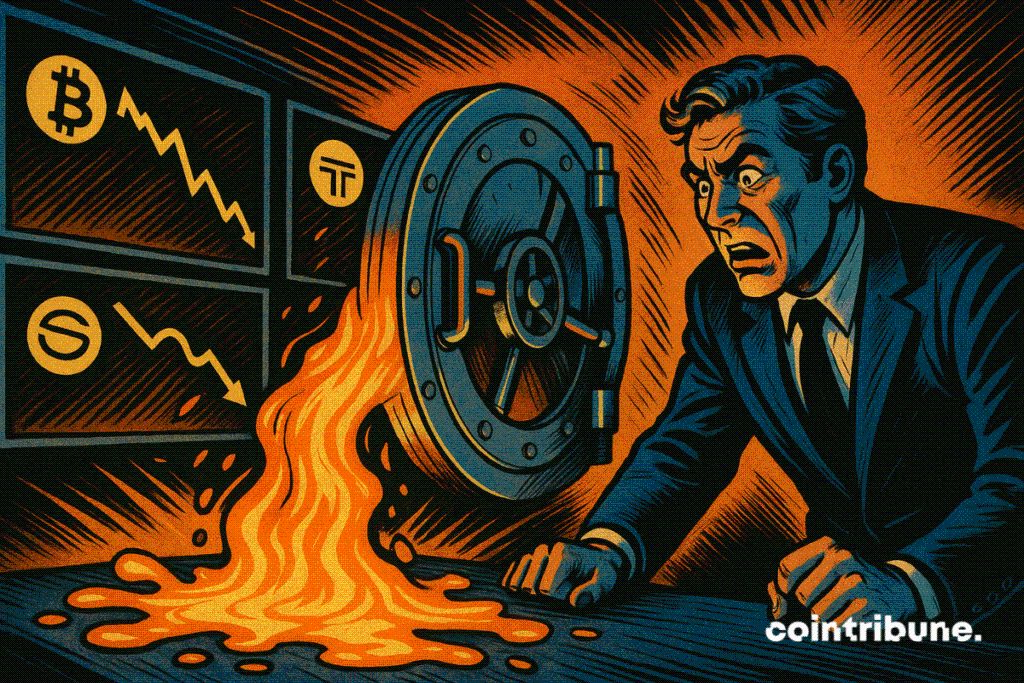Crypto Market’s Capital Outflows Intensify as Bitcoin ETFs, Stablecoins, and DAT Activity Weaken
Crypto markets are showing signs of strain as several key measures of capital flow turn negative. Recent data points to a broad cooling of demand across Bitcoin ETFs, stablecoins, and corporate treasury activity. And as expected, this trend has raised concerns that the rally’s core drivers have stalled.

In brief
- Spot Bitcoin ETFs see billions in outflows as redemptions accelerate and demand cools across major investment products.
- Stablecoin supply contracts for the first time in months, with USDE losing nearly half its circulating supply after October’s shock.
- Corporate DAT structures flip from premiums to discounts, pushing firms from BTC accumulation toward selling assets or buybacks.
- October’s $19B liquidation event set off a feedback loop that continues to pressure prices despite large institutional purchases.
Spot Bitcoin ETFs Shed Billions as Stablecoin Supply Falls Across the Market
According to NYDIG’s latest report, the current pressure is tied less to sentiment and more to structural changes that began in early October. Persistent outflows from spot Bitcoin ETFs have become one of the most notable shifts in market behavior this year. These products, which absorbed billions in the first half of 2024, are now experiencing steady redemptions.
Data from SoSoValue shows that November outflows reached $3.55 billion, just shy of the $3.56 billion record set in February. Weekly figures tell a similar story, with about $1.2 billion leaving the market over just seven days—one of the sharpest retreats since these products went live.
A harsh 24-hour window on Thursday saw more than $900 million pulled out as Bitcoin fell to $81,000, its lowest point since April.
Stablecoin activity mirrors the downturn. Total supply has declined for the first time in months after the Oct. 10 liquidation shock . USDE, once a rapidly growing algorithmic token, has lost nearly half its supply.
Greg Cipolaro, global head of research at NYDIG, said the rapid contraction in USDE signals that money is leaving the system altogether, especially after the token fell to $0.65 on Binance during the selloff.
Outflows Deepen as DAT Structures Reverse and Stablecoin Supply Falls
Corporate treasury activity tied to DAT share premiums is also unwinding. Earlier in the year, many firms issued shares to accumulate Bitcoin when share prices traded above net asset value.
With those premiums gone—and in some cases turning to discounts—several companies have reversed course. Sequans recently sold BTC to reduce debt, which shows how quickly these structures can shift when market conditions change.
The report cites several key mechanical pressures:
- ETF redemptions are replacing earlier inflows.
- Contraction in stablecoin supply indicating capital exit.
- USDE’s supply drop is reducing liquidity in trading pairs
- DAT structures are shifting from premium to discount.
- Firms are moving from BTC accumulation to asset sales or buybacks.
Large purchases by Strategy and El Salvador during Bitcoin’s slide toward $84,000 offered little support. Cipolaro said the inability of significant buys to slow the decline suggests that deeper forces are at work. He noted that the Oct. 10, $19 billion liquidation event set off a feedback loop that continues to pressure prices as mechanisms that once supported the rally now work in reverse.
Cipolaro cautioned that investors should prepare for near-term volatility, even as longer-term views remain intact. Market cycles often repeat familiar patterns, and current conditions point to another uneven stretch ahead. Still, he maintains that long-term conviction carries weight , even as capital outflows reshape the short-term outlook.